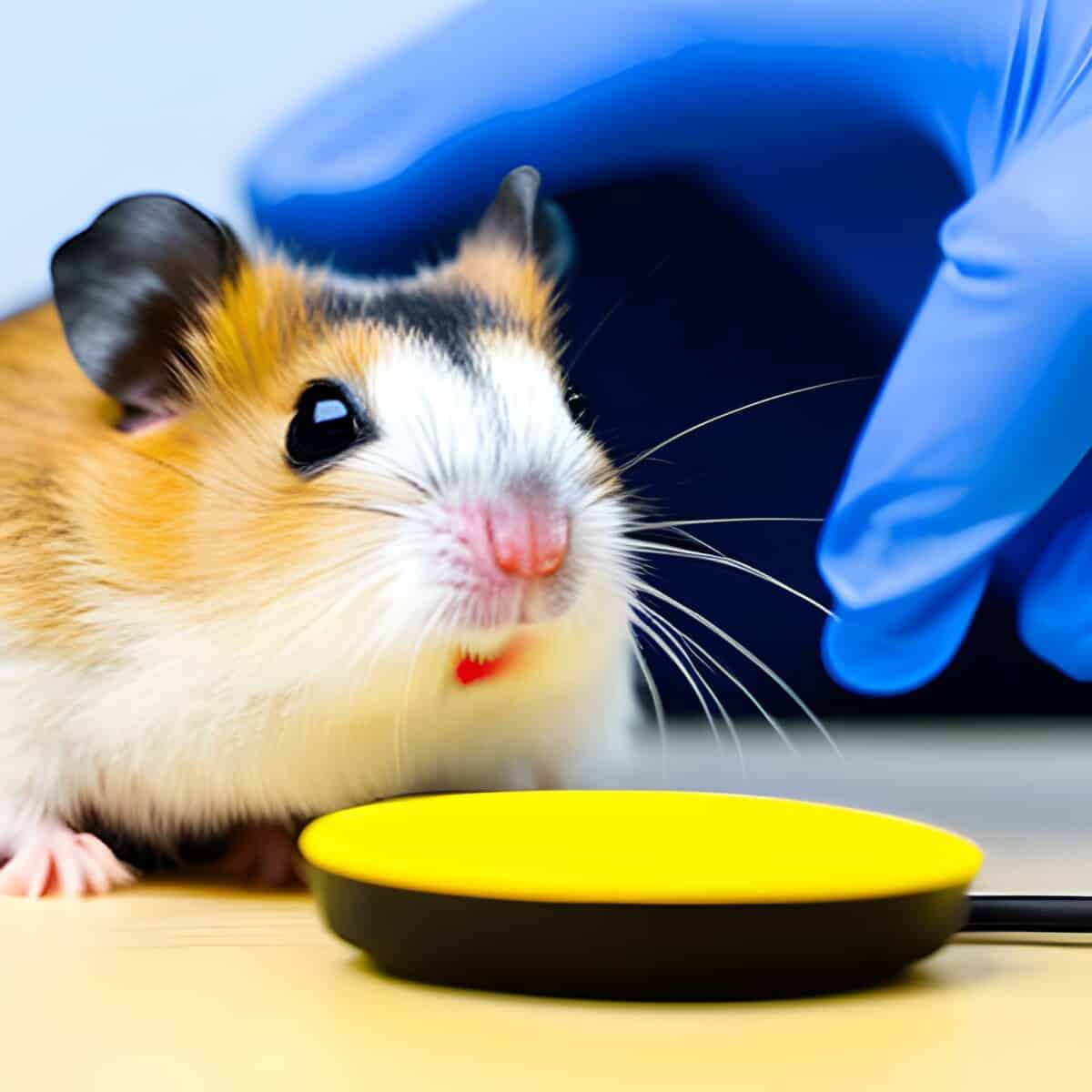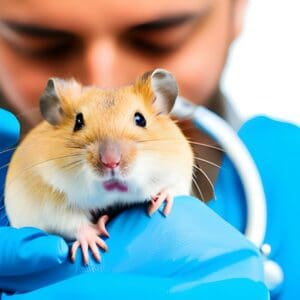Hamsters, the adorable little pets that can bring a lot of joy to your life can unfortunately develop health problems too.
One of the most common issues is an eye infection also known as pink eye or conjunctivitis.
Hamster eye infections can be caused by dust or other irritants, injuries, or bacterial or viral infections and it affects senior hamsters (senior rodents) more frequently. Luckily, treating a hamster’s eye infection is straightforward, and most cases can be resolved with home remedies or a visit to the veterinarian.
Hamster Eye Infection: Table of Contents
What is Conjunctivitis (Pink Eye) in hamster

Conjunctivitis is an irritation or inflammation of the conjunctiva, which is the soft tissue lining the inside of the eyelids and the white portion of the eyes.
It can be caused by:
- Bacterial infections: Bacteria like Staphylococcus and Streptococcus can infect the conjunctiva, the membrane lining the eyelids and eyeball.
- Viral infections: Viruses like the adenovirus and calicivirus can cause conjunctivitis in hamsters.
- Allergies: Dust, mites, or bedding materials can trigger allergic reactions in some hamsters, leading to eye irritation and inflammation.
- Foreign bodies: Dust, sawdust, or even a loose thread from bedding can get into a hamster’s eye, causing irritation and infection.
- Dental problems: Overgrown teeth or an abscess in the mouth can put pressure on the tear duct, causing eye discharge and inflammation.
Symptoms of Conjunctivitis in hamsters include:
- swelling of the eye or area
- presence of pus (green or yellow)
- cloudy eyes, sticky eyes (hamsters unable to open their eyes properly)
- puffy eyes, and redness around the eye
- crusting around the eyes
If you notice any of these signs in your hamster, it is important to take them to the vet as soon as possible for appropriate treatment, which may include antibiotics.
Common Causes of Eye Infections in Hamsters
Eye infections can be painful and uncomfortable for your furry friend, The most common cause of eye infections is poor sanitation where the hamster is kept.
This can lead to the build-up of bacteria and other harmful microorganisms that can cause inflammation and infection.
It’s important to keep your hamster’s living space clean and well-ventilated to prevent the growth of harmful bacteria. Make sure to clean your hamster’s cage regularly and provide fresh bedding and water.
Other causes may include allergies, dental issues, or injury to the eye area.
Being aware of these common causes can help you take steps to prevent future infections in your pet.
Hamster Eye Infection Symptoms
Common symptoms include:
- swollen, watery, or red eyes
- discharge from the eyes
- excessive scratching or rubbing of the eye area.
Treatment for hamster eye infections may include antibiotics or anti-inflammatory medications, depending on the severity of the infection.
Your veterinarian may also recommend warm compresses or eye drops to help soothe your hamster’s eyes and reduce inflammation.
Remember, early detection and treatment are key to preventing serious complications from hamster eye infections. If you suspect your hamster has an eye infection, don’t hesitate to seek veterinary care.
Preparing for Treatment
Before you begin treating your hamster for an eye infection, there are a few things you need to do to prepare.
The first step is to gather all the necessary supplies, such as cotton balls, warm water, saline solution, and eye drops. You’ll also want to create a safe and comfortable environment for your hamster during treatment.
1. Gather Necessary Supplies
Cotton balls and warm water can be used to gently clean the eye area, while saline solution and eye drops can help flush out any bacteria or debris.
Make sure you have all the supplies you need before you begin treatment.
2. Create a Safe and Comfortable Environment for Your Hamster
During treatment, your hamster may be feeling uncomfortable or scared, so it’s important to create a safe and comfortable environment for them.
This can include providing them with a familiar hiding spot or covering their cage with a blanket to reduce stress. It’s also important to work in a well-lit space with a steady hand to avoid hurting your pet.
How to Treat Hamster Eye Infection at Home
Once you have everything you need, you can begin treating your hamster’s eye infection with home remedies. There are several different home remedies you can try, which include:
3. Clean the Affected Eye
Clean the affected eye gently with cotton balls dipped in warm water. The warmth of the water can help soothe your hamster’s eye and break up any debris or discharge.
4. Apply a Warm Compress
A warm compress can reduce swelling and ease discomfort. Dip a clean cloth in warm water and hold it against your hamster’s eye for a few minutes at a time, repeating several times throughout the day.
Make sure the compress isn’t too hot to avoid burning your pet.
5. Over-the-Counter Eye Drops
Over-the-counter eye drops designed for humans can be used on your hamster with caution. Let your veterinarian prescribe the appropriate one, and be sure to follow the dosage instructions carefully.
When to Consult a Veterinarian
If you have been using home remedies and your hamster’s eye infection has not improved within two to three days or if it appears to be getting worse, it’s time to seek the advice of a veterinarian.
Other warning signs include:
- loss of appetite
- lethargy
- excessive itchiness of the eye area
What to Expect During a Vet Visit
The veterinarian will examine your hamster and may prescribe medicated eye drops or antibiotics to treat the infection. Any underlying conditions or injuries will also be identified during the examination and treated accordingly.
6. Prescription Medications
Some medications may need to be applied to the eye area or mixed in with food. Follow the dosage and administration instructions carefully to ensure your hamster gets the appropriate amount and that the medication does not harm them.
How to Prevent Future Eye Infections
The best way to ensure your hamster stays healthy is by preventing eye infections from occurring in the first place. Here are some tips:
7. Maintain a Clean Living Environment
To prevent eye infections, it’s important to keep your hamster’s living area clean and well-ventilated. Clean the cage regularly and change the bedding frequently to avoid a build-up of bacteria.
Remove any excess food or waste to ensure it doesn’t collect near their living area.
8. Monitor Your Hamster’s Health
Regularly monitoring your hamster’s health can help identify any potential health issues before they get worse.
You can follow Hamster Care Guide and ask your vet for guidance on potential issues.
Check your pet’s eyes and other areas of their body regularly for any signs of swelling, redness, or discharge.
9. Provide a Balanced Diet and Proper Hydration
A healthy diet is essential for your hamster’s overall health. Provide your pet with a balanced diet that includes fresh fruits and vegetables, as well as high-quality hamster food. Also, ensure that fresh water is available at all times.
Other Hamster Eye Issues
Proptosis/Exophthalmos in Hamsters
Proptosis, also known as exophthalmos, refers to the protrusion of the eye from its normal position in the orbit.
Hamsters develop exophthalmos in relation to a condition called sialodacryoadenitis. Sialodacryoadenitis can lead to keratoconjunctivitis sicca and subsequent exophthalmos and proptosis in hamsters.
In general, proptosis/exophthalmos in animals, including hamsters, is often caused by:
- traumatic events such as blunt force injury
- fights with other animals
- excessive physical restraint
During the trauma, the globe (the eyeball) becomes displaced from the orbit, and the eyelids may become entrapped behind the globe, preventing its return to its normal position.
To provide appropriate care for a hamster with proptosis/exophthalmos, it is crucial to seek veterinary attention immediately.
The veterinarian will perform a thorough examination to confirm the diagnosis based on the clinical appearance of the eye, including its protrusion and the inability of the eyelids to blink over the cornea.
Treatment options may include globe replacement surgery (GRS), which involves returning the displaced eye to its normal position in the orbit.
Postoperative therapy typically includes medications such as antibiotics, anti-inflammatories, and analgesics.
Cataracts in Hamsters
Cataracts in hamsters refer to the opacity or cloudiness of the lens of the eye, which can result in partially or severely decreased vision and potentially lead to permanent blindness.
Cataracts in hamsters are characterized by a milky appearance in the eyes. This condition is more commonly seen in older hamsters and does not typically cause them pain.
The diagnosis of cataracts in hamsters is primarily based on clinical signs and observation of the cloudy appearance of the eyes. A veterinarian with experience in treating small mammals or exotic pets can provide a thorough examination to confirm the diagnosis.
While it may not be possible to prevent cataracts from occurring, providing a balanced diet, appropriate living conditions, and regular veterinary care can contribute to your hamster’s overall health and potentially delay the onset of age-related eye conditions.
Bulging eye/exophthalmos in Hamsters
Bulging eyes in hamsters, also known as exophthalmos, refers to the protrusion or bulging of one or both eyes.
Bulging eyes in hamsters are characterized by the abnormal protrusion of the eyes, which may appear larger than usual.
Other symptoms that may be observed include swelling, redness, and inflammation of the eyes].
Diagnostic procedures may include checking for signs of trauma, evaluating for infections, or assessing for other underlying diseases or conditions.
There can be various causes for bulging eyes in hamsters, including trauma, underlying disease, infection, or other factors.
Treatment for bulging eyes in hamsters will depend on the underlying cause.
In cases where the condition is caused by an infection or underlying disease, appropriate medications such as antibiotics or anti-inflammatory drugs may be prescribed by the veterinarian.
Bulging eyes in hamsters should be considered an emergency and should receive immediate veterinary attention.
Prompt diagnosis and treatment can help alleviate discomfort, prevent further complications, and improve the overall well-being of your hamster.
Glaucoma in Hamsters
Glaucoma is a condition characterized by increased pressure within the eye, which can lead to damage to the optic nerve and potential vision loss.
Glaucoma in hamsters is considered a severe condition, and unfortunately, there is no specific treatment available for it.
In some cases, the eye may appear to bulge or be swollen, and in severe cases, it may even rupture.
The veterinarian will perform a thorough examination, which may include tonometry, a procedure to measure intraocular pressure.
To manage the condition and stabilize intraocular pressure (IOP) medication that increases aqueous outflow or decreases its production could be used.
The disease is usually progressive, and hamsters with glaucoma may eventually experience permanent blindness and, in severe cases, loss of the affected eye.
Owners should be observant of any changes in their hamster’s behavior or signs of discomfort. In cases where blindness occurs, most hamsters can still live normal, happy lives as they rely less on vision and more on their other senses. It is important to make accommodations in the hamster’s environment to ensure their safety and well-being.
Hamster Eye Infection Takeaways
Treating a hamster’s eye infection is vital to keep them in good health and prevent further health issues. By understanding the causes and symptoms of eye infections, preparing well, and administering home remedies or seeking professional help when needed, you can quickly and effectively treat your pet.
It’s also crucial to prevent future eye infections from occurring in the first place, and by keeping your hamster’s living environment clean and providing them with a healthy diet and fresh water, you can help ensure they stay healthy and happy for years to come.
You might be interested in:
My Senior Paws is a participant in the Amazon Services LLC Associates Program, an affiliate advertising program designed to provide a means for sites to earn advertising fees by advertising and linking to Amazon.com. We also participate in other affiliate programs which compensate us for referring traffic.




